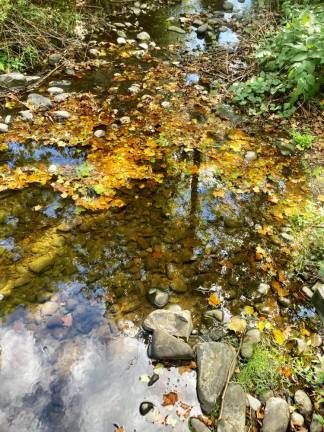
Every living creature needs food, water, shelter and space — often in surprisingly specific ways.
In summer, Monarch butterflies need milkweed for their larvae to feed on and only milkweed will do. Then they migrate to a totally different habitat, overwintering in southern Mexico.
In spring, golden-winged warblers need low, scrubby, tangled thickets to breed and raise young — but also need tall, healthy woodlands nearby to feed.
Salamanders need pools of water to lay their eggs. But the water can’t be permanent. And it can’t be too deep, or too sunny, or too far from the woodsy, loamy leaf litter of shady trees, where salamanders live in the damp earth.
Humans lived in the woods and along the creeks of the Brodhead watershed for thousands of years. From the rich mosaic of woodland, meadows, creeks and wetlands, rocky caves, bogs and marshes came shelter, game, fish and shellfish, fruit and nuts, and the raw materials for making arrowheads and watercraft.
Our human connection to the mosaic of habitats that sustains life may seem more tenuous these days. But as heatwaves and downpours break records, that connection remains very real.
In Allentown, Pa., a multi-billion dollar international company recently opened their new global headquarters. Instead of smothering their campus in a blanket of emerald lawn, they chose a native-meadow landscape instead.
The native grasses and wildflowers they planted support the mosaic — a living refuge for birds, pollinators, amphibians, and small mammals — in the middle of sprawl. They included trails, benches, and sculpture, so employees can refresh their spirits here, too.
A growing number of gardeners, businesses, and property owners in the Brodhead watershed are following a similar path. In the process, a former golf course is returned to its natural state, becoming home to eagles and butterflies. An old railroad bed becomes a wooded, creek-side trail. A lawn close-clipped right down to the edge of a creek is allowed to grow freely, sprouting wild elderberries.
Allowing and encouraging native mosaics to take hold is good for humans, makes sense for nature — and saves money, too. Turf grass lawns provide almost no habitat and are extravagant, expensive, and time-consuming users of water, fuel, fertilizers and pesticides.
We’ll never fully return to the balance of many habitats that the earliest inhabitants of the Brodhead watershed would recognize. But everyone can make their difference. You could quit mowing along the creek or let your back fence line go wild. Let the goldenrod grow. Plant a few native shrubs.
Then take a look around — you might feel right at home.